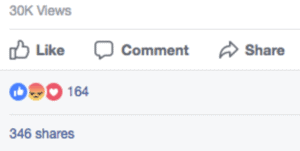
Our animations have a knack for getting people talking.
Because we engage with new scientific concepts, illustrate political issues, and share the work of social impact organizations all over the world, our viewers often have something to say!
Just look at the range of comments on the video we made for the Centre for Gender Advocacy in Quebec (more likes and loves than angry faces for sure).
For many of our clients, getting a conversation going is one of their main goals. But how do you promote healthy conversation on your video, rather than feeding trolls?
Regardless of your content, making your videos public and open for comment means that disagreement is a strong possibility. Conflict on social media is so common, that in the last month both Facebook and Instagram have initiated design changes to promote instantaneous conversation (and hopefully prevent paragraphs of shouting over each other).
Here are some guidelines we would suggest for getting people talking about your key issues without having a mini explosion on your hands.
1) Take a stance, but acknowledge multiple sides.
If you really want to get people talking, you’re going to have to make a clear statement. Many of our clients are passionate about the environment, their communities, their customers, or their mission, so that’s not hard! If your statement is controversial, you may want to frame the video intentionally with a well-written caption and description to help mitigate squabbling. You can preemptively acknowledge the opposition in your description to cut off a lot of those initial, knee-jerk reactions:
“We know that Americans are worried about their jobs, and having a secure future for their children. However, our team doesn’t think that cutting DACA is the solution. Watch our video to learn about immigration status and the DREAM Act in America!”
Look, you’ve already responded to potential opposing comments in a polite and respectful manner! And you didn’t even have to change the content of your video.
2) Have a code of conduct, either in theory or clearly posted.

Sometimes you’re going to have to delete comments. When comments are clearly spam, most people understand why they would be deleted. But often times organizations fall under scrutiny for “censoring” their commenters. You can avoid this scrutiny or ill-will amongst viewers by creating a list of reasons why your organization justifies deleting comments. Common items on codes of conduct include: “No swearing, no racist comments, no personal attacks” and other generals like this. Now you have both a clear and consistent guide to when you should be deleting comments, as well as a solid explanation for why the comment was deleted. You can private message a commenter, letting them know they broke your code of conduct, or you can post a comment to the thread, notifying everyone. Either way, you can backup your decision with a fair, consistent policy designed to promote healthy dialogue and weed out the trolls.
3) Respond with levity and cheerful ignorance.
Many people who comment on videos are not emotionally invested, or are just looking for a fight. Take a page from the book of dog-instagrammer-turned-meme-originator We Rate Dogs, and respond to hate-comments with an upbeat attitude, no matter how negative the comments.
Don’t let the fear of conflict prevent you from spreading your message. Hopefully these tips will help you navigate controversial video content with confidence, without sacrificing your vision or watering down your message.




